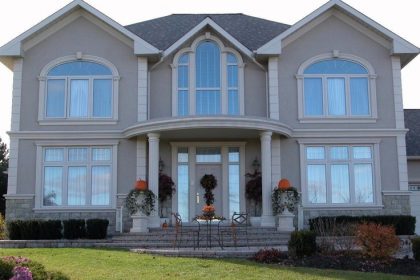
New building and construction frames come with a nailing fin to attach the frame to the studs throughout the construction of the new home. The replacement frame is basically the new building frame minus the nailing fin.
But in the west, where stucco houses prevail, makers created a 3rd kind of frame called a retrofit frame. The retrofit frame has a fin about 2 inches large, situated flush with the outside face of the window. This is the very best option when replacing old windows, but not all tasks will accomodate a retrofit frame application. Let’s go over how to identify which frame is going to work for you.
If you have a stucco outside, retrofit is the way to go. You install the new window from the outdoors, and the flush fin covers the old aluminum frame that you are going to leave in place. You screw the new window in using deck screws through the side channels as well as the leading header. We will enter into more detail on the actual setup in a future short article. If you have a stucco outside, however there is a wood trim around the opening of the window where the flush fin would normally go, you can still utilize the retrofit style frame. You would need to eliminate the wood surrounding the opening, set up the retrofit window, then purchase and install new wood trim. The old trim will no longer fit because the retrofit window frame dimensions will be larger in width and height than the old window frame. Another choice is to set up the retrofit fin on top of the wood trim. You can do this as long as the depth from the face of the wood trim to the point in your home of the inner part of the old aluminum frame is less than 3 inches deep. Since an excellent quality retrofit window will have a 3 inch frame depth from the back of the flush fin to the inner part of the frame, the factor is. That inner part needs to be further into your house than the innermost part of the aluminum frame so that the aluminum frame will be hidden after we apply the inside trim. Exactly what if you have brick around the window openings? Or siding? Then exactly what? Well, if you can install the window versus the face of the brick or siding and still have the innermost part of the vinyl frame be further into the home than the old frame, then you can utilize the retrofit style frame. If not, then you need to utilize the replacement design frame, then use trim to complete the exterior. You can likewise trim down the fins so the window fits between the brick or wood if you are able to get a retrofit frame with a relatively thin fin. That would get rid of the have to cut out the outside. Some manufacturers of retrofit frames will have grooves in the back of the retrofit fins. You merely run an utility knife in the groove up until you have the ability to break off that piece of the fin.
The bottom line to bear in mind when determining whether to use a retrofit frame or a standard replacement frame is that in order to utilize the retrofit frame there has to be less than 3 inches from the outdoors point where the flush fin will rest to the within point in the space where the old frame ends. If it’s less than 3 inches, opt for the retro, more than 3 inches, use the replacement frame and add trim to the outside in lieu of the flush fin.
Next week I am going to explain the procedure of removing the old aluminum window.
New building and construction frames come with a nailing fin to connect the frame to the studs throughout the building of the new house. In the west, where stucco houses are typical, producers came up with a third type of frame called a retrofit frame. The old trim will no longer fit considering that the retrofit window frame measurements will be larger in width and height than the old window frame. The reason is because an excellent quality retrofit window will have a 3 inch frame depth from the back of the flush fin to the inner part of the frame. Well, if you can install the window against the face of the brick or siding and still have the inner part of the vinyl frame be further into the house than the old frame, then you can utilize the retrofit design frame.

